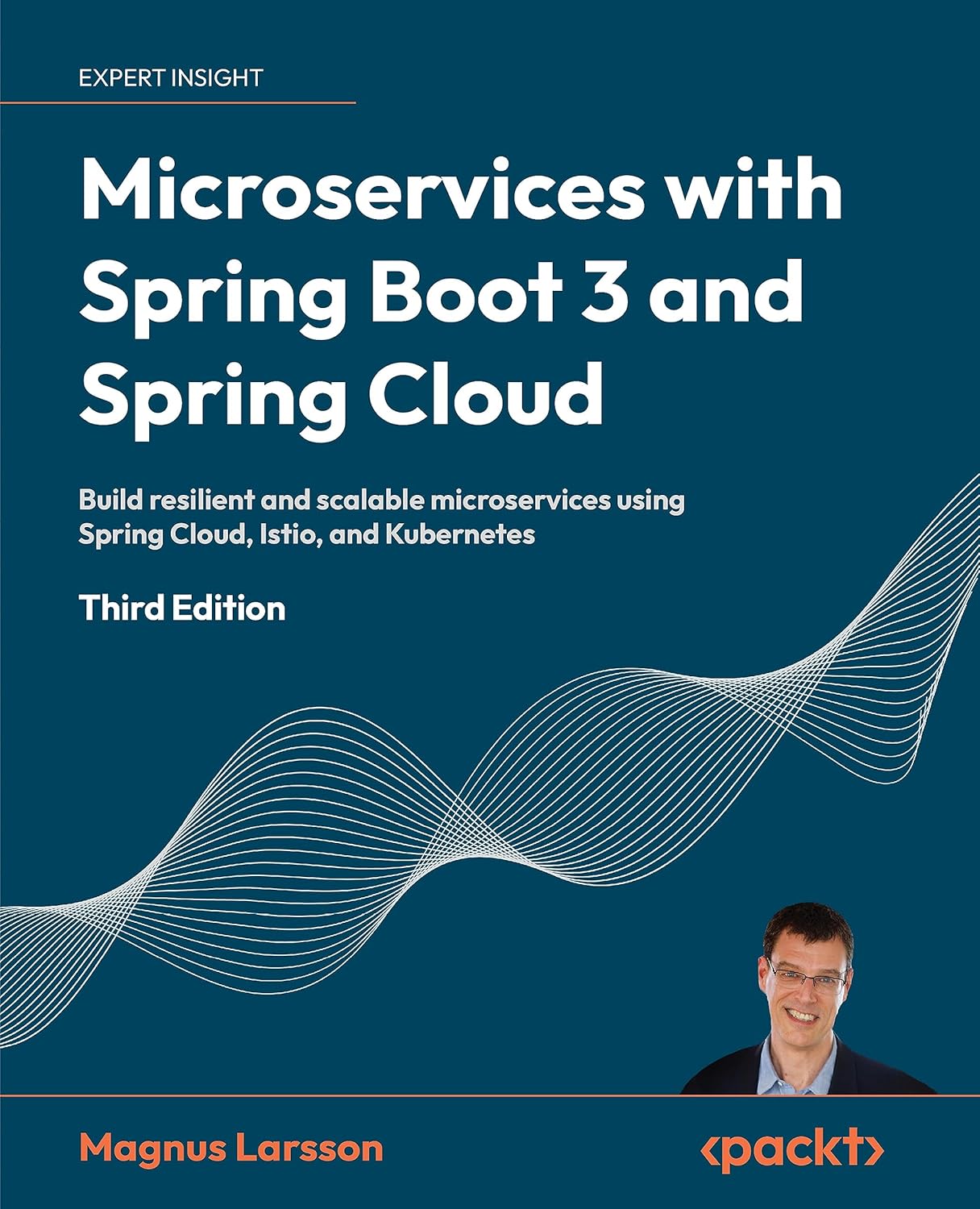Price: $30.31
(as of Dec 15,2024 00:42:50 UTC – Details)

From the Publisher




From the Preface:
This book is about building production-ready microservices using Spring Boot 3 and Spring Cloud. Ten years ago, when I began to explore microservices, I was looking for a book like this.
This book was developed after I learned about, and mastered, open-source software used for developing, testing, deploying, and managing landscapes of cooperating microservices.
This book primarily covers Spring Boot, Spring Cloud, Docker, Kubernetes, Istio, the EFK stack, Prometheus, and Grafana. Each of these open-source tools works great by itself, but it can be challenging to understand how to use them together. In some areas, they complement each other, but in other areas they overlap, and it is not obvious which one to choose for a particular situation.
This is a hands-on book that describes step by step how to use these open-source tools together.


Chapter Highlights:
Chapter 3, Creating a Set of Cooperating Microservices, will teach you how to create a set of cooperating microservices from scratch. You will use Spring Initializr to create skeleton projects based on Spring Framework 6.0 and Spring Boot 3.0. The idea is to create three core services (that will handle their own resources) and one composite service that uses the three core services to aggregate a composite result. Toward the end of the chapter, you will learn how to add very basic RESTful APIs based on Spring WebFlux. In the next chapters, more and more functionality will be added to these microservices.
Chapter 9, Adding Service Discovery Using Netflix Eureka, will show you how to use Netflix Eureka in Spring Cloud to add service discovery capabilities. This will be achieved by adding a Netflix Eureka-based service discovery server to the system landscape. You will then configure the microservices to use Spring Cloud LoadBalancer to find other microservices.


Chapter 11, Securing Access to APIs, will explain how to protect exposed APIs using OAuth 2.0 and OpenID Connect. You will learn how to add an OAuth 2.0 authorization server based on Spring Authorization Server to the system landscape, and how to configure the edge server and the composite service to require valid access tokens issued by that authorization server. You will learn how to expose the authorization server through the edge server and secure its communication with external consumers using HTTPS.
Chapter 17, Implementing Kubernetes Features to Simplify the System Landscape, will explain how to use Kubernetes features as an alternative to the Spring Cloud services. You will learn why and how to replace Spring Cloud Config Server with Kubernetes Secrets and ConfigMaps, as well as how to replace Spring Cloud Gateway with Kubernetes Ingress objects and add cert-manager to automatically provision and rotate certificates for external HTTPS endpoints.


Chapter 20, Monitoring Microservices, will show you how to monitor the microservices deployed in Kubernetes using Prometheus and Grafana. You will learn how to use existing dashboards in Grafana to monitor different types of metrics, and you will also learn how to create your own dashboards. Finally, you will learn how to create alerts in Grafana that will be used to send emails with alerts when configured thresholds are passed for selected metrics.
At the end of every chapter, you’ll find some straightforward questions that will help you recap some of the content covered in the chapter. Assessments is a file that can be found in the GitHub repository containing the answers to these questions.
ASIN : B0CCYZNS7V
Publisher : Packt Publishing; 3rd edition (August 31, 2023)
Publication date : August 31, 2023
Language : English
File size : 26516 KB
Text-to-Speech : Enabled
Screen Reader : Supported
Enhanced typesetting : Enabled
X-Ray : Not Enabled
Word Wise : Not Enabled
Print length : 706 pages
Microservices architecture has become increasingly popular in recent years due to its ability to improve flexibility, scalability, and resilience of applications. In this post, we will explore how to build resilient and scalable microservices using Spring Boot 3 and Spring Cloud, along with Istio and Kubernetes.
Spring Boot is a popular Java-based framework for building microservices, providing a simple and efficient way to develop standalone, production-ready applications. Spring Cloud complements Spring Boot by offering a set of tools for building distributed systems and microservices architecture.
Istio is a powerful service mesh that provides advanced traffic management, security, and observability features for microservices. Kubernetes, on the other hand, is a popular container orchestration platform that helps manage and scale applications deployed in containers.
By combining these technologies, developers can build robust microservices architectures that are resilient to failures, scalable to handle varying loads, and easily manageable in production environments.
In this post, we will cover topics such as:
– Setting up a microservices project with Spring Boot 3 and Spring Cloud
– Implementing service discovery and load balancing using Spring Cloud Netflix Eureka
– Integrating Istio for advanced traffic management, security, and observability
– Deploying microservices to Kubernetes clusters and managing them effectively
– Implementing fault tolerance and resilience patterns using Spring Cloud Circuit Breaker and Istio’s fault injection capabilities
By the end of this post, you will have a solid understanding of how to build resilient and scalable microservices using Spring Boot 3, Spring Cloud, Istio, and Kubernetes. Stay tuned for more updates on this exciting topic!
#Microservices #Spring #Boot #Spring #Cloud #Build #resilient #scalable #microservices #Spring #Cloud #Istio #Kubernetes









